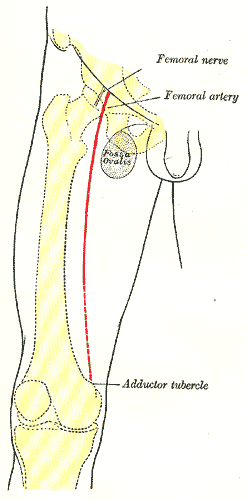Long saphenous vein
Long Saphenous Vein
The Long Saphenous Vein (also known as the Great Saphenous Vein) is the largest vein in the human body, running along the length of the lower limb. It is a superficial vein meaning it is close to the surface of the body.
Anatomy[edit | edit source]
The Long Saphenous Vein originates from where the dorsal vein of the big toe merges with the dorsal venous arch of the foot. From here, it runs up the medial side of the leg, passing over the medial malleolus and up the medial side of the thigh. It then passes through the saphenous opening in the fascia lata to drain into the femoral vein.
Clinical significance[edit | edit source]
Due to its size and superficial location, the Long Saphenous Vein is often used in coronary artery bypass surgery to replace blocked arteries. It is also the vein most commonly affected by varicose veins.
See also[edit | edit source]
References[edit | edit source]
External links[edit | edit source]
Translate: - East Asian
中文,
日本,
한국어,
South Asian
हिन्दी,
தமிழ்,
తెలుగు,
Urdu,
ಕನ್ನಡ,
Southeast Asian
Indonesian,
Vietnamese,
Thai,
မြန်မာဘာသာ,
বাংলা
European
español,
Deutsch,
français,
Greek,
português do Brasil,
polski,
română,
русский,
Nederlands,
norsk,
svenska,
suomi,
Italian
Middle Eastern & African
عربى,
Turkish,
Persian,
Hebrew,
Afrikaans,
isiZulu,
Kiswahili,
Other
Bulgarian,
Hungarian,
Czech,
Swedish,
മലയാളം,
मराठी,
ਪੰਜਾਬੀ,
ગુજરાતી,
Portuguese,
Ukrainian
Navigation: Wellness - Encyclopedia - Health topics - Disease Index - Drugs - World Directory - Gray's Anatomy - Keto diet - Recipes
Search WikiMD
Ad.Tired of being Overweight? Try W8MD's physician weight loss program.
Semaglutide (Ozempic / Wegovy and Tirzepatide (Mounjaro / Zepbound) available.
Advertise on WikiMD
WikiMD is not a substitute for professional medical advice. See full disclaimer.
Credits:Most images are courtesy of Wikimedia commons, and templates Wikipedia, licensed under CC BY SA or similar.Contributors: Prab R. Tumpati, MD

